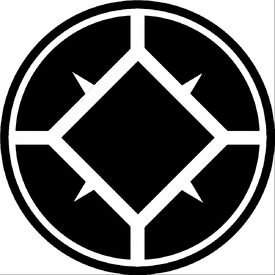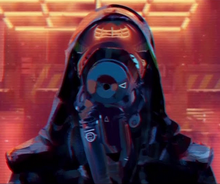|
Kiith Gaalsien
| |
|---|---|

| |
| Kiith Information | |
|
Members
|
|
|
Locations
|
|
|
On Hiigara?
|
No
|
Kiith Gaalsien was a major religious kiith present on Kharak. Although never seen in the games, up until Homeworld: Deserts of Kharak, it was mentioned in lore documents that their history stretched back to the earliest days of occupation on Kharak. They are the main antagonists of Homeworld: Deserts of Kharak and are attempting to stop Coalition of the Northern Kiithid from seeking the Jaraci Object in the Great Banded Desert.
History
Kiith Gaalsien's symbol was in the Khar-Toba, alongside those of Kiithid S'jet, Somtaaw, Manaan, Paktu, Soban, and Naabal. Many of the old records showed the Gaalsien symbol in greater prominence than the other Kiithid, which could possibly mean that they were the leaders of the Hiigaran people during Khar-Toba's time.
Kiith Gaalsien's earliest days in modern history were recorded in the ancient manuscripts of Kharak. Between 75 and 250 KDS the Gaalsien survived various ecological disasters, after which they moved farther north toward the pole of Kharak, where the more temperate areas allowed the Kushan to create their first settlements and begin the long climb towards civilization.
However there were many Kiithid who had lived in this region before the arrival of the Gaalsien and as such they became one of the many minor Kiithid at the north pole. Around 480 KDS, Kiith Gaalsien become one of two most powerful kiithid of the north pole, save Kiith Siidim, there was no other kiithid capable of waging war against them.
Kushan archaeologists believed that circa 520 KDS it was Kiith Gaalsien who actually started the Heresy Wars, in order to bring the various smaller Kiithid under Gaalsien rule. After nearly 300 years of war Kiith Gaalsien's power had not grown, and when the Heresy Wars were ended by the intervention of Kiith Naabal, the Gaalsien became even more zealous in their ways.
Circa 910 KDS, when the Time of Reason was at its zenith, Kiith Gaalsien's power began to wane. The Kiithid had only thirty vassal families and one city left under it's rule, making it one of the least powerful Kiithid on Kharak. Fortunately the city, Saju-ka, was one of the wonders of Kharak. It was in Saju-ka that the most ancient and priceless works of Kushan civilization were kept.
To defend Saju-ka against the rapidly progressing desertification of the valley where city was built, the Great Engineer, Gar Naabal, designed various structures that would stop the influx of sand. Without these structures the city would have been swallowed whole by the desert. Unfortunately, in year the 917 KDS Miirpat Gaalsien-Sa ordered his people to blow up every structure defending the city against sand, and within two days the entire city was buried. For this the Daiamid punished Kiith Gaalsien, and condemned every one of them to exile.
The people of Kiith Gaalsien became nomads of the Great Banded Desert, still fanatically worshiping Sajuuk and performing rituals in his name. By this time the Gaalsien had begun to attack any scientific community that was situated near the Desert or in it, and writing prophecies which foretold the end of the Kushan race. Several military expeditions were undertaken to hunt down and punish Kiith Gaalsien, but each and every one of them failed. It was during this time that various myths began to surround Kiith Gaalsien.

Khagaan Gaalsien, commander of the Gaalsien invasion of the North, wearing a typical Gaalsien mask.
By 1110 KDS the Gaalsien were led by a Kiith-Sa known as the K'Had Sajuuk. Around this time a survey probe owned by the Coalition of the Northern Kiithid detected an anomaly within the Great Banded Desert that they believed was an ancient starship. Despite it being deep within Gaalsien territory, the Coalition commissioned an expedition led by Kiith S'jet to explore this anomaly. Coinciding with this, the Gaalsien attacked the North for entering into space, an act of heresy that violated their most sacred beliefs. Using superior technology from ancient starship wrecks scattered within the Great Banded Desert the Gaalsien under the command of the warlord Khagaan mounted a highly successful invasion of the northern hemisphere, destroying the Coalition's frontier bases and laying siege to the capital city of Tiir.
The S'jet expedition land carrier Kapisi and its sister ship, the Siidim carrier Sakala, were launched despite this invasion and penetrated deep into the Gaalsien heartlands. Gaalsien forces harassed the expedition throughout its entire journey. Initially led by Khagaan, the Kapisi's fleet was able to destroy her carrier, the Ashoka and kill her. Despite this setback and the loss of two more carriers, Gaalsien resistance remained heavy. Eventually the Kapisi reached the anomaly and activated an centuries-old derelict Taiidan orbital weapon and turned it to their advantage. The K'Had Sajuuk intercepted the Kapisi at the wreck of the Khar-Toba with his flagship, the Hand of Sajuuk, but was defeated. His final words were of regret and fear for the future of Kharak, now that the Kushan's return to space seemed inevitable - a sentiment that would ring true, as the Taiidan Empire destroyed Kharak and the majority of the Kushan species for doing so.
In modern times, acts of sabotage made during the construction of the Mothership were said to be inspired by the Gaalsien, and it is more than likely that there were still families connected in some way with Kiith Gaalsien. It is unknown (and very unlikely, given their pariah status with other Kiiths) if any member of Kiith Gaalsien managed to get on board the Mothership and journey to the promised land of Hiigara.
Religion
Kiith Gaalsien believed that the Kushan people were left on inhospitable Kharak as a punishment by Sajuuk. They believed that eventually their sentence would be completed and Sajuuk would lift them up into heaven. It was because of this that Kiith Gaalsien created various dogmas and methods, which allowed them to survive in the harshest of conditions, such as when they were exiled by the Daiamid. The Gaalsien believed that every misfortune that happened to them was a punishment for their arrogance, this arrogance being the reason why they were banished from celestial paradise.
After learning of the Coalition of Northern Kiithid's intent to recover the technology of the ruined Khar-Toba deep within their territory, the Gaalsien viewed this as an act of supreme heresy. Any attempt to return the Kushan to space was blasphemy of the highest order, provoking a massive Gaalsien invasion of Kharak's northern hemisphere in a punitive holy war.
Due to the extensive number of shipwrecks discovered in Gaalsien territory during the Coalition's expedition to Khar-Toba and evidence that Kiith Gaalsien had been salvaging from them for years, it is suspected that the leaders of Kiith Gaalsien have known the truth about the Kushan people's exile to Kharak by the Taiidan Empire for a very long time, and of the Taiidan's intention to violently suppress any attempts by the Kushan to regain their former empire and technology. This would have been a very possible fundamental basis for their religious beliefs that going into space would bring catastrophe to the Kushan people.
Technology And Army
In comparison to the Coalition forces, the Kiith Gaalsien army is more decentralized and individualistic, with a heavier focus on hit-and-run tactics. Their units are typically faster and lighter than their Coalition counterparts, and virtually all of them have the ability to self repair when they are out of combat. Because of this they have not focused as heavily on remote repair systems like the Coalition, and can have great difficulty dealing with a concentrated heavy force of the demonstrably tougher large Coalition vessels backed up by remote repair support ships.
For unit construction, the Gaalsien command ships don't actually build light combat vessels themselves such as Sand Skimmer (Gaalsien), instead they rely on Production Cruiser (Gaalsien) ships to do nearly all small vessel construction other than Salvagers. This means that a Gaalsien force with a lot of resources will be able to produce a massive number of light vessels if they field a number of Production Cruisers, far more than the Coalition, but they will extremely suffer in heavy vehicle construction. Rather unsurprisingly they have a wider variety of light vehicles at their disposal, yet only two dedicated combat Cruisers (the Honorguard and Artillery cruisers). Further proving their preference for mobility, in multiplayer matches the Gaalsien simply research increases to their fleet capacity instead of relying on deployed logistics structures like the Coalition, and their command ship has a movement speed energy system instead of the Coalition carrier's remote repair system.
